The Asia Foundation is, on the surface, a private non-profit that contributes to the development of Asia, including donating millions of books. In reality, since it was created by Central Intelligence Agency in 1951, TAF has engaged in a decades long campaign to misrepresent its origins, purpose, and funding.

Originally conceived by CIA as a propaganda machine and a front for covert activities including psychological warfare, TAF has controlled its narrative by becoming the primary source of information on its organization. The narrative presented by TAF effectively erases the first years of its history and misleads the public about its sources of funding over the years. TAF’s deceptions aren’t limited to the public, either. Declassified documents reveal that TAF provided information to the State Department that was incorrect and misleading; this information was subsequently given to Congress. These misrepresentations were then cited in the findings of Congress’ “Asia Foundation Act”, which provides funding for the Foundation, and have become commonly referenced.
This article, like its predecessor on Robert Blum, is based on a review of more than 1,000 pages of declassified CIA documents from CIA’s administrative file on DTPILLAR, which was the Agency’s cryptonym for what was publicly known as the Committee for a Free Asia and later The Asia Foundation. While most of the operational specifics remain redacted, the administrative file contains enough information to debunk a number of misconceptions and outright lies regarding TAF and its past activities.
The root of TAF’s misrepresentations is that it was founded in 1954. According to their website and press releases released by the foundation, “In 1954, a group of forward-thinking citizens who shared a strong interest in Asia, distinguished personal achievements, and dedicated public service established The Asia Foundation.” This not only gets the year wrong, 1951, it presents the sort of narrative in which a gun fires itself with no mention of who assembled the gun, loaded it with ammunition, aimed it, and pulled the trigger.
Constantly repeated by TAF, this version of events has become almost universally accepted as fact and is now repeated by federal agencies, no doubt relying on TAF’s information and the Congressional finding which also relied on TAF’s information. Aside from TAF’s statements, there are few primary sources that can be said to support the notion that TAF was either founded or incorporated in 1954 and that the Committee for a Free Asia was a distinct that TAF was a successor to. They appear to be simple, imprecisely worded mistakes, likely confused by the fact that the organization’s name changed from CFA to TAF in 1954.
The evidence that the CFA and TAF are the exact same entity and not successor organizations, however, is both abundant and beyond doubt. CIA’s contemporary documents on the group document the name change and its purpose, leaving no question that it was simply a name change. According to the formerly SECRET document, the CFA name had become a problem for the CFA’s image. It had “a political connotation” and it irritated Asians who objected to the notion that they needed to be freed. “Therefore, the name is being changed to “The Asia Foundation” and appropriate organizational changes are being made in that connection.” The clear intention is that it was simply a change to the organization, not a replacement.

Additional evidence that CFA merely changed its name to TAF come from the organization’s own financial filings. The very first document in CIA’s declassified file on CFA and TAF describes the Articles of Incorporation for the CFA. At the bottom of the first page of the file, it lists the CFA as having been incorporated on March 12, 1951.

According to records with the California Secretary of State, that is the date that TAF registered itself with the state. While the records show that the organization’s records were amended in April 1957, there is no registration or amendment listed for 1954.
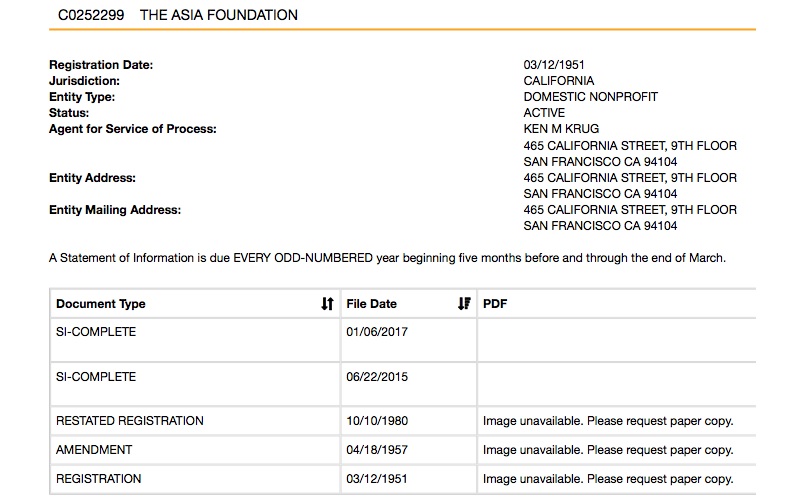
Additional records from the IRS also confirm that TAF’s existence predated 1954 and that it’s the same organization as the CFA. According to a letter sent from the IRS to TAF in 2004, the nonprofit and federal tax-exempt status of TAF was determined in March of 1952. This date was not only accepted by TAF, it has been included on multiple filings with the IRS as its “year of formation,” including 2014 - the year they publicly declared they had been in existence for exactly sixty years.
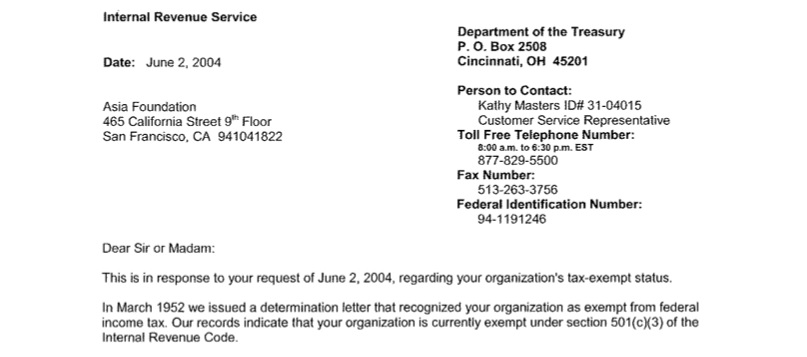
While TAF’s financial filings show that it acknowledged that the IRS had recognized their tax-exempt status since 1952, other documents show that TAF was not always so honest and transparent with the government. The Asia Foundation’s Trustees’ Discussion Paper on the Foundation’s Future Status and Funding was prepared for the State Department in 1981 as an aid for the State Department in making recommendations on the future of TAF, as requested by Congress. This paper was accepted by the State Department and presented to Congress in the widely cited Congressional Research Service report of 1983. Following several smaller incorrect or misleading statements, the paper stated that TAF’s predecessor was the CFA, but repeated the misleading statement that “In 1954 the Committee was transformed into The Asia Foundation, which was incorporated in the State of California as non-profit tax exempt organization.“ This language, crafted with careful consideration, gives the impression that TAF was incorporated in 1954 as a separate successor organization, though as shown above, this was simply not the case.

This claim would be uncritically repeated by the CRS report, and then regurgitated once more by Congress as one of their findings in the Asia Foundation Act, which provided long term funding the TAF’s core, operational expenses
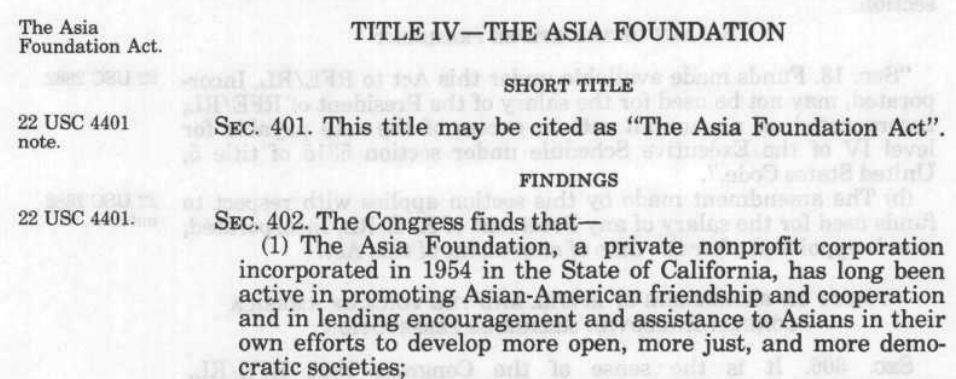
Since then, the claim has been uncritically repeated by many outlets, including government publications such as the website of the U.S. Embassy in Japan and the reports from U.S. Agency for International Development. The claim is now also being repeated in reference books, such as the Historical Dictionary of Pakistan.
The Trustees’ paper also falsely claimed that “the Foundation was not used for clandestine intelligence purposes.” This would be repeated in the core of CRS report, and has been largely accepted as the truth. The Trustees then presented an extremely overly simplified version of how TAF’s Agency affiliation became disclosed, and what exactly “enabled it to survive the disclosure.” As shown below, both of these claims are misleading at best.

These misstatements continue to this day. In addition to the previously mentioned references on TAF’s website to it being founded in 1954, it’s 60th anniversary publication makes similar claims. “From 1954 until 1967, The Asia Foundation had been supported by covert funding from the U.S. government, as were many universities, nonprofit organizations, and civic associations in the post-war era.” As shown below, the CFA/TAF operated off of covert CIA funding and support since before its incorporation in 1951 and as late as 1969.
According to the Project Outline Clearance Sheet, DTPILLAR was first developed on January 26th, 1951. While the names of the developer and the Foreign Branch and Division/Staff Chiefs who reviewed the project are all redacted, the redaction for name of the Foreign Branch Chief missed the bottom of the first name and middle initial. These appear to be George H., a name which will come up again soon.

While the project was approved a week and a half later, on February 7th. the Financial Control Plan would not be submitted until March and approved in April. The April approval would result in several documents erroneously listing the project approval as April 1951. Nearly all of those have handwritten corrections noting that it was February.

Contrary to the claims by TAF that they were not engaged in covert intelligence activities, that was one of their explicit purposes from the beginning. According to CIA’s documents, the purposes that the CFA would serve included the creation of new groups to fight communism both ”directly and in cooperation with OPC’s covert missions.” The CFA would also “greatly simplify OPC’s problem of making contact with existing or potential groups.” The Office of Policy Coordination, or OPC, was the branch of CIA then responsible for psychological warfare and covert operations. Other documents, discussed below, show that this was merely the beginning of the covert intelligence functions that CFA and later TAF would fulfill.

While TAF claims that it was founded on the initiative of “forward thinking citizens” that had the “approval” of the NSC, CIA’s administrative file shows otherwise. These “forward thinking citizens” were in fact selected by CIA, and the “impetus to the formation of the Committee will be given to three selected persons.” These people would not only be aware of the OPC’s interest, they would “exercise controlling authority” under OPC’s direction.

More significantly, the declassified file stated that “control by OPC will be exerted directly over the President, who will be a contract agent.” Among other things, this means that if Blum hadn’t worked for CIA before he joined CFA/TAF as was alleged, he did afterward. OPC’s “direct” control would be absolute in theory, but “in practice” it would largely be limited “to general policy guidance” and “a period review of activities and accounts.” While the “general policy guidance” admittedly sounds mundane, it flatly contradicts the statements by TAF and its representatives that the Agency’s funding “in no way affected” TAF’s policies and programs. Other documents would explain that CFA/TAF were expected to coordinate with the local Embassies and the CIA Station Chiefs in addition to coordination between TAF and CIA’s domestic offices.

The documents show that the CIA security and employment contracts were not limited to the president of CFA/TAF. According to one of the project’s initiating documents, any key officials who were aware of Agency’s sponsorship and receiving any compensation “should be placed on a covert contract basis with CIA.”. This would seem to include the three people that CIA had initially approached to form the CFA.

As late as 1963, CIA had direct control over the leadership of the foundation. According to the revised Administrative Plan, all Trustees were approved by the Covert Action Staff prior to their election. Similarly, CA Staff were to approve key staff officers and anyone elected or appointed to the Executive Committee. The President, however, would not only be approved by the CA Staff, but selected by them.

According to one document in the CREST archive, as early as 1953 the Agency was considering assigning personnel to “tours of duty” with the CFA. Due to the sensitivity of the use of Agency employees, this wasn’t announced alongside similar programs involving CIA and State Department personnel.

The DTPILLAR administrative file went on to further contradict TAF’s assertions that they didn’t participate in covert intelligence activities. According to the file, it was anticipated that eventually the group would be able to “provide cover to such groups covertly established to lend propaganda support to major [Far East] projects … which aim at the development of guerilla and popular political resistance movements.” CFA/TAF would, in other words, be involved in aiding the creation and growth of guerilla resistance movements. This process was to include the production of propaganda to aid in the funding of these groups.

These documents show that from the earliest days, CIA was very protective of CFA’s cover. The Agency’s concern drove it to plan on preemptively notifying the FBI about the project with instructions not to investigation the group.

According to the first document in the declassified DTPILLAR file, the President pro tem was George H. Greene, whose first name and middle initial are found on the initiating documents for DTPILLAR. Like the future TAF president Robert Blum, Greene had been the chief of an ECA mission to Asia.

A memo dated April 17th, 1951, written in response to DTPILLAR’s Financial Control Plan which was approved the same day, their current candidate to be the President of DTPILLAR was an Agency employee at the time. The candidate in question had already been approved by the Executive Committee and several other senior CIA personnel to be the president of DTPILLAR. While the candidate isn’t named in the typed text, it appears that “Green” was written in the margin, with the end of the name cut-off. The second paragraph notes that “it had been long planned that the candidate, a staff employee with some seniority in grade GS-15, would resign from the Agency and accept an Agency contract.”
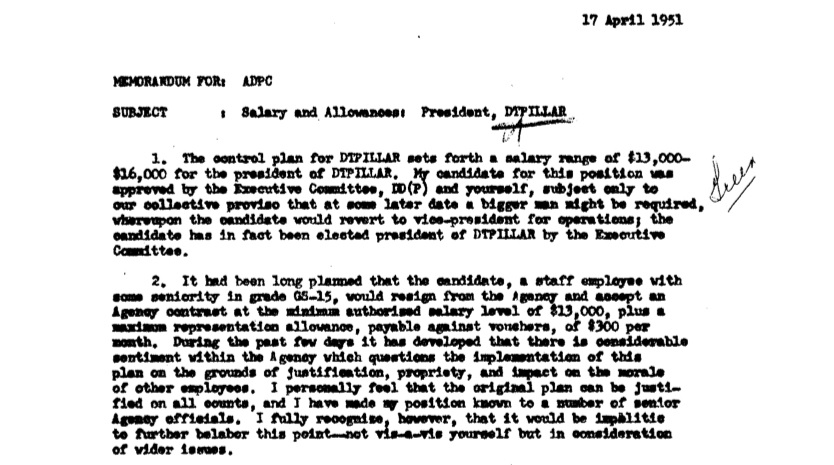
This indicates that George H. Greene was a CIA staff employee until he became President of the CFA. Given the circumstances, it seems extremely likely that this is the same George H. who reviewed the project for CIA as a Foreign Branch Chief. After playing a role in the development and review of the project, it appears Greene retired from the Agency to run the project directly as a CIA contract employee and as the President of CFA.
By the end of the year, Greene’s tenure had come to an end. Memos written by Greene’s successor would look back on it as a troubled time, with the result being that Alan Valentine took over as President despite Greene’s rather strenuous objections who was “choked with rage” over the situation. Soon after, Valentine began purging the group of some people he felt Greene should never have involved. He also laid out the groundwork for much of the group’s operations. Throughout March, Valentine wrote a series of memos describing the group’s procedures, functions and operations. This was the same month that the IRS first recognized the group’s federal tax-exempt status.
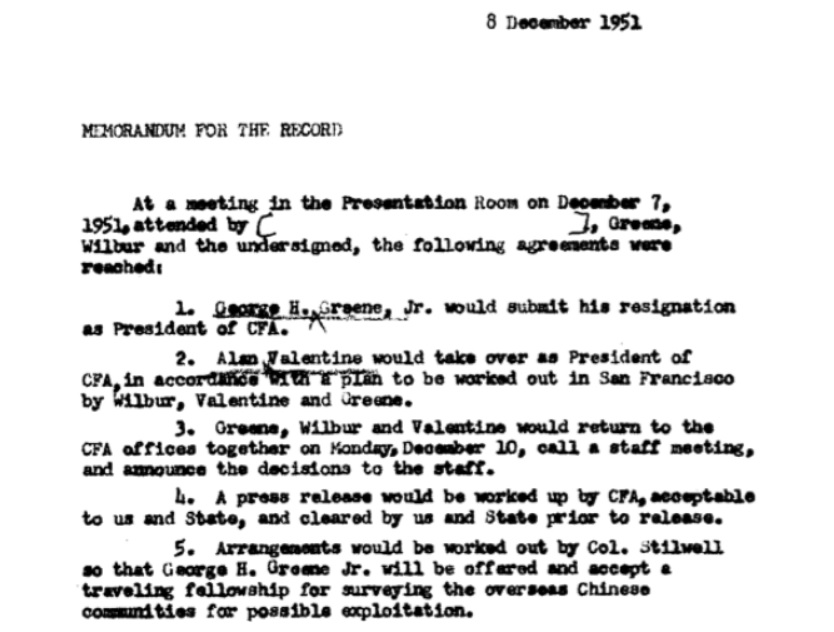
A memo authored later that month reaffirmed that even with Greene out of the picture, the Agency’s intent was to use CFA as “an instrument of psychological warfare” and “a vehicle for covert operations.”
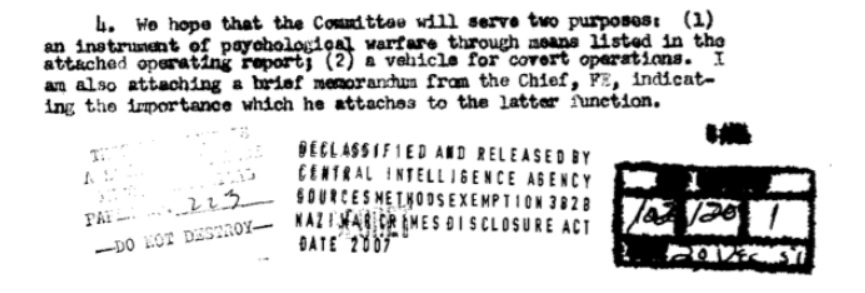
An accompanying document states directly that the CFA was “an instrumentality of OPC for the conduct of [psychological warfare], including political warfare, and for providing cover for OPC covert activities.” TAF’s claims that they weren’t used for covert intelligence activities is consistently at odds with CIA’s own record in the administrative file.

According to a formerly SECRET document authored that same week, the CFA’s priorities at that time included “developing personnel who might be trained for intelligence, stay-behind or other missions.” Even by the most literal definitions and interpretations, this shows that CFA was designed to play a role in CIA’s covert intelligence efforts.
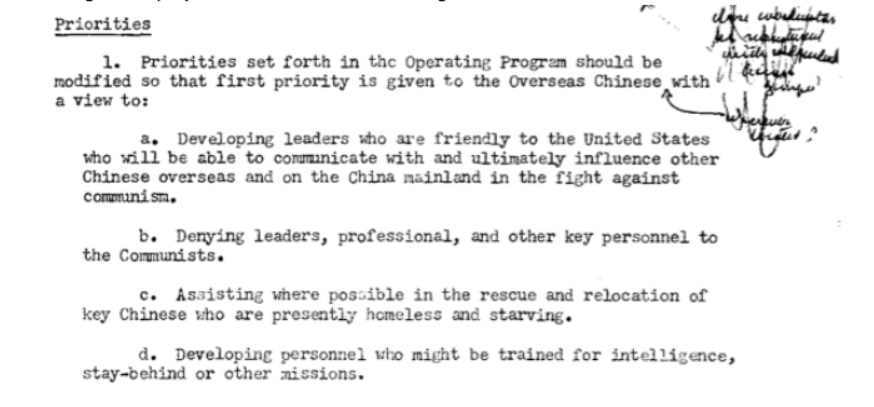
Documents also show that the Agency planned to transfer many existing psychological warfare projects to the CFA. The documents also show that the group would provide the Agency with a way to train both “indigenous and Caucus personnel” as well as for the “recruitment of covert operatives.”

According to one of the documents in the file on QKACTIVE, CIA’s program to weaken the Soviet regime, the local CIA representatives were to coordinate with TAF to provide access to “key contacts” and “key indigenous personnel” that might help with “a psywar” or other covert action after an evacuation of American personnel.

According to a Request for Covert Action Renewal from the mid-1960s, this would be one of the most successful aspects of CFA/TAF’s operations. TAF’s operations in Cambodia remained “fully operative” following the “withdrawal of all Americans, officials and private citizens.” As a result of The Asia Foundation’s work in the region and their success cultivating assets and relationships, they were able to remain in Cambodia and provide both the State Department and CIA with a way to indirectly operate after being forced to withdraw. According to CIA’s file, this allowed them to “operate quite effectively” despite the circumstances.


Numerous documents in the CIA administrative file show that while the group received Agency funds, it was involved not only in furthering policy goals but in explicit propaganda, psychological and political warfare, the creation and bolstering of guerilla groups, recruiting and functioning as a stay-behind force, the passing of intelligence and helping CIA and the State Department plan operations of shared interest. While many examples of this in the administrative file focus on the group providing information that they came across in the course of their other activities, documents show they were also expected to respond to CIA tasking for specific information.

Similarly, Blum also provided the Agency with reports about his activities and information gained from contacts during his time as President of The Asia Foundation.
An important piece of TAF’s narrative about its organizational history is the end of its relationship with CIA. The Foundation’s Trustees’ description of the termination of CIA’s financial support and direct control of the group is as misleading as their statement that TAF wasn’t involved in covert intelligence activities. The content of TAF’s statement was repeated in the body of the 1983 Congressional Research Service Report (shown below), with equally misleading results.

TAF’s relationship with CIA had been discussed, but had remained publicly unconfirmed, for years. Prior to TAF’s misleading and incorrect characterization of that relationship, they had been directly accused of it by foreign governments, including Cambodia’s. Interestingly, the accusation appears to come from the same Prince Sihanouk whose positive relationship with TAF had been credited by the Agency with the success of the Cambodian stay-behind effort.

According to the CIA administrative file, the CFA/TAF had been the subject of accusations of CIA ties since it was less than a year old. The Agency, naturally, had helped the CFA craft their response.

Nor, as implied by the Trustees’ paper and the CRS report, was the media truly responsible for the exposure of TAF’s relationship with CIA. Neither of the two media articles typically cited, including by books from Oxford University Press, accused The Asia Foundation of being funded by the Agency. Ramparts only mentioned TAF to say that, to the best of their sources’ knowledge, “CIA money did not pass through” it. The New York Times article doesn’t mention TAF at all. Even within the CIA archive, there are no examples public references to TAF being funded by the Agency - only that TAF had received money from other groups that were in turn funded by the Agency.

None of the allegations appear to have argued that TAF was directly or wittingly funded by CIA, though both were the case.
Read Part Two Here
Like Emma Best’s work? Support her on Patreon.
Image by CIA Flickr




